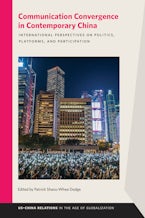In a speech opening the nineteenth Chinese Communist Party Congress meeting in October 2017, President Xi Jinping spoke of a “New Era” characterized by new types of communication convergence between the government, Party, and state media. His speech signaled that the role of the media is now more important than ever in cultivating the Party’s image at home and disseminating it abroad. Indeed, communication technologies, people, and platforms are converging in new ways around the world, not just in China. This process raises important questions about information flows, control, and regulation that directly affect the future of US–China relations. Just a year before Xi proclaimed the New Era, scholars had convened in Beijing at a conference cohosted by the Communication University of China and the US-based National Communication Association to address these questions. How do China and the United States envision each other, and how do our interlinked imaginaries create both opportunities for and obstacles to greater understanding and strengthened relations? Would the convergence of new media technologies, Party control, and emerging notions of netizenship in China lead to a new age of opening and reform, greater Party domination, or perhaps some new and intriguing combination of repression and freedom? Communication Convergence in Contemporary China presents international perspectives on US–China relations in this New Era with case studies that offer readers informative snapshots of how these relations are changing on the ground, in the lived realities of our daily communication habits.
ContentsIntroduction: Communication Convergence and “the Core” for a New EraPart 1. Convergence and Fragmentation in the “New Era”On the Paradox of Convergence and Fragmentation in the Age of Globalization-Stephen J. Hartnett, Zhengrong Hu, Qingwen Dong, Zhi Li, and Patrick Shaou-Whea DodgeConvergence and Fragmentation in the Umbrella Revolution: A Rhetorical Analysis of the Mainlandization of Hong Kong-Andrew GilmoreFragmentation and Convergence in the Construction of National Imaginaries in US and Chinese Documentaries-Zhi Li and Xi WangPart 2. Communication and Crisis in the Age of ConvergenceDueling Narratives of Distrust, Hypocrisy, and Blame: The 2014 US–China Cyber Controversy-Michelle Murray Yang and Da WangHuawei and the 2019 Cybersecurity Crisis: Sino–US Conflict in the Age of Convergence-Jufei Wan and Bryan R. ReckardEvolving Forms of Citizen Engagement in the Age of Convergence: The 2016 Baidu and Ctrip Crises as Case Studies in Critique, Trust, and Hope in Contemporary China-Jack Kangjie Liu and Dan WangPart 3. Case Studies in the Changing Mediascape of ChinaRebuilding in Unity: The 2015 Tianjin Explosions and Renewal Discourses in Chinese Social Media-Lisa B. Keränen and Yimeng LiCode Switching and Language Games in Contemporary China; or, Convergence and Identity Construction on WeChat-Todd L. Sandel and Peimin Qiu“Plowing Fortunes,” or Fine Wine with Chinese Characteristics: US and UK Media Representations of the Chinese Wine Industry-David R. GruberConclusion: US–China Communication and a New Type of Great Power RelationsAcknowledgmentsAbout the ContributorsIndex

